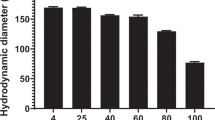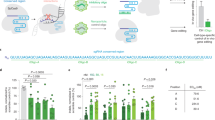Abstract
The impact of hydrodynamic injection on liver structure was evaluated in mice using various microscopic techniques. Upon hydrodynamic injection of approximately 9% of body weight by volume, the liver rapidly expanded, reaching maximal size at the end of the injection and returned to its original size in 30 min. Histological analysis revealed a swollen appearance in the peri-central region of the liver where delivery of genes and fluorescence-labeled markers was observed. Scanning and transmission electron microscopy showed enlargement and rupture of endothelium that in about 24–48 h regains its morphology and normal function as a barrier against infection by adenovirus viral particles. At the cellular level in hydrodynamically treated animals, four types of hepatocytes were seen: cells with normal appearance; cells with enriched vesicles in the cytoplasm; cells with lightly stained cytosol; and cells with significant dilution of the cytoplasm. In addition, red blood cells and platelets were observed in the space of Disse and even inside hepatocytes. Vesicle formation is triggered by hydrodynamic injection and resembles the process of macropinocytosis. These results, whereas confirming the physical nature of hydrodynamic delivery, are important for a better understanding of this efficient method for intrahepatic gene and small interfering RNA delivery.
This is a preview of subscription content, access via your institution
Access options
Subscribe to this journal
Receive 12 print issues and online access
$259.00 per year
only $21.58 per issue
Buy this article
- Purchase on Springer Link
- Instant access to full article PDF
Prices may be subject to local taxes which are calculated during checkout







Similar content being viewed by others
References
Liu F, Song Y, Liu D . Hydrodynamics-based transfection in animals by systemic administration of plasmid DNA. Gene Therapy 1999; 6: 1258–1266.
Zhang G, Budker V, Wolff JA . High levels of foreign gene expression in hepatocytes after tail vein injections of naked plasmid DNA. Hum Gene Ther 1999; 10: 1735–1737.
Al-Dosari M, Knapp JE, Liu D . Hydrodynamic delivery. Adv Genet 2005; 54: 66–82.
Hodges BL, Scheule RK . Hydrodynamic delivery of DNA. Expert Opin Biol Ther 2003; 3: 911–918.
Hagstrom JE . Plasmid-based gene delivery to target tissues in vivo: the intravascular approach. Curr Opin Mol Ther 2003; 5: 338–344.
Kim KS, Park YS . Antitumor effects of angiostatin K1-3 and endostatin genes coadministered by the hydrodynamics-based transfection method. Oncol Res 2005; 15: 343–350.
Ortaldo JR, Winkler-Pickett RT, Bere Jr EW, Watanabe M, Murphy WJ, Wiltrout RH . In vivo hydrodynamic delivery of cDNA encoding IL-2: rapid, sustained redistribution, activation of mouse NK cells, and therapeutic potential in the absence of NKT cells. J Immunol 2005; 175: 693–699.
Chen L, Woo SL . Complete and persistent phenotypic correction of phenylketonuria in mice by site-specific genome integration of murine phenylalanine hydroxylase cDNA. Proc Natl Acad Sci USA 2005; 102: 15581–15586.
Ajuf'ev BN, Dizhe EB, Efremov AM, Mogilenko DA, Oleinikova GN, Lapikov IA et al. Hydrodynamics-based transfer of human apolipoprotein A-I gene in mice: study of factors affecting the efficiency and duration of gene expression in the mouse liver. Mol Biol 2005; 38: 921–928.
Ye P, Thompson AR, Sarkar R, Shen Z, Lillicrap DP, Kaufman RJ et al. Naked DNA transfer of factor VIII induced transgene-specific, species-independent immune response in hemophilia A mice. Mol Ther 2004; 10: 117–126.
Razzini G, Parise F, Calebiro D, Battini R, Bagni B, Corazzari T et al. Low-density lipoprotein (LDL) receptor/transferrin fusion protein: in vivo production and functional evaluation as a potential therapeutic tool for lowering plasma LDL cholesterol. Hum Gene Ther 2004; 15: 533–541.
Higuchi N, Maruyama H, Kuroda T, Kameda S, Iino N, Kawachi H et al. Hydrodynamics-based delivery of the viral interleukin-10 gene suppresses experimental crescentic glomerulonephritis in Wistar–Kyoto rats. Gene Therapy 2003; 10: 1297–1310.
Jiang JJ, Yamato E, Miyazaki J . Long-term control of food intake and body weight by hydrodynamics-based delivery of plasmid DNA encoding leptin or CNTF. J Gene Med 2003; 5: 977–983.
Kishida T, Asada H, Itokawa Y, Cui FD, Shin-Ya M, Gojo S et al. Interleukin (IL)-21 and IL-15 genetic transfer synergistically augments therapeutic antitumor immunity and promotes regression of metastatic lymphoma. Mol Ther 2003; 8: 552–558.
Kobayashi N, Kuramoto T, Chen S, Watanabe Y, Takakura Y . Therapeutic effect of intravenous interferon gene delivery with naked plasmid DNA in murine metastasis models. Mol Ther 2002; 6: 737–744.
Lui VW, He YK, Falo L, Huang L . Systemic administration of naked DNA encoding interleukin 12 for the treatment of human papillomavirus DNA-positive tumor. Hum Gene Ther 2002; 13: 177–185.
Dai CS, Li YJ, Yang JW, Liu YH . Hepatocyte growth factor preserves beta cell mass and mitigates hyperglycemia in streptozotocin-induced diabetic mice. J Biol Chem 2003; 278: 27080–27087.
Yang PL, Althage A, Chung J, Chisari FV . Hydrodynamic injection of viral DNA: a mouse model of acute hepatitis B virus infection. Proc Natl Acad Sci USA 2002; 99: 13825–13830.
Ehrhardt A, Peng PD, Xu H, Meuse L, Kay MA . Optimization of cis-acting elements for gene expression from nonviral vectors in vivo. Hum Gene Ther 2003; 14: 215–225.
Miao CH, Ye X, Thompson AR . High-level factor VIII gene expression in vivo achieved by nonviral liver-specific gene therapy vectors. Hum Gene Ther 2003; 14: 1297–1305.
Wen JH, Matsumoto K, Taniura N, Tomioka D, Nakamura T . Hepatic gene expression of NK4, an HGF-antagonist/angiogenesis inhibitor, suppresses liver metastasis and invasive growth of colon cancer in mice. Cancer Gene Ther 2004; 11: 419–430.
Zhang G, Song YK, Liu D . Long-term expression of human alpha 1-antitrypsin gene in mouse liver achieved by intravenous administration of plasmid DNA using a hydrodynamics-based procedure. Gene Therapy 2000; 7: 1344–1349.
Gehrke S, Jerome V, Muller R . Chimeric transcriptional control units for improved liver-specific transgene expression. Gene 2003; 322: 137–143.
Xu ZL, Mizuguchi H, Ishii-Watabe A, Uchida E, Mayumi T, Hayakawa T . Optimization of transcriptional regulatory elements for constructing plasmid vectors. Gene 2001; 272: 149–156.
Yant SR, Meuse L, Chiu W, Ivics Z, Izsvak Z, Kay MA . Somatic integration and long-term transgene expression in normal and haemophilic mice using a DNA transposon system. Nat Genet 2000; 25: 35–41.
Yew NS, Przybylska M, Ziegler RJ, Liu DP, Cheng SH . High and sustained transgene expression in vivo from plasmid vectors containing a hybrid ubiquitin promoter. Mol Ther 2001; 4: 75–82.
Al-Dosari M, Zhang G, Knapp JE, Liu D . Evaluation of viral and mammalian promoters for driving transgene expression in mouse liver. Biochem Biophys Res Commun 2006; 339: 673–678.
Alino SF, Crespo A, Dasi F . Long-term therapeutic levels of human alpha-1 antitrypsin in plasma after hydrodynamic injection of nonviral DNA. Gene Therapy 2003; 10: 1672–1679.
Stoll SM, Sclimenti CR, Baba EJ, Meuse L, Kay MA, Calos MP . Epstein-Barr virus/human vector provides high-level, long-term expression of alpha 1-antitrypsin in mice. Mol Ther 2001; 4: 122–129.
Lewis DL, Hagstrom JE, Loomis AG, Wolff JA, Herweijer H . Efficient delivery of siRNA for inhibition of gene expression in postnatal mice. Nat Genet 2002; 32: 107–108.
McCaffrey AP, Meuse L, Pham TT, Conklin DS, Hannon GJ, Kay MA . Gene expression – RNA interference in adult mice. Nature 2002; 418: 38–39.
Song E, Lee SK, Wang J, Ince N, Ouyang N, Min J et al. RNA interference targeting Fas protects mice from fulminant hepatitis. Nat Med 2003; 9: 347–351.
Zender L, Hutker S, Liedtke C, Tillmann HL, Zender S, Mundt B et al. Caspase 8 small interfering RNA prevents acute liver failure in mice. Proc Natl Acad Sci USA 2003; 100: 7797–7802.
Condiotti R, Curran MA, Nolan GP, Giladi H, Ketzinel-Gilad M, Gross E et al. Prolonged liver-specific transgene expression by a non-primate lentiviral vector. Biochem Biophys Res Commun 2004; 320: 998–1006.
Brunetti-Pierri N, Palmer DJ, Mane V, Finegold M, Beaudet AL, Ng P . Increased hepatic transduction with reduced systemic dissemination and proinflammatory cytokines following hydrodynamic injection of helper-dependent adenoviral vectors. Mol Ther 2005; 12: 99–106.
Zhang G, Gao X, Song YK, Vollmer R, Stolz DB, Gasiorowski JZ et al. Hydroporation as the mechanism of hydrodynamic delivery. Gene Therapy 2004; 11: 675–682.
Crespo A, Peydro A, Dasi F, Benet M, Calvete JJ, Revert F et al. Hydrodynamic liver gene transfer mechanism involves transient sinusoidal blood stasis and massive hepatocyte endocytotic vesicles. Gene Therapy 2005; 12: 927–935.
Stolz DB, Ross MA, Salem HM, Mars WM, Michalopoulos GK, Enomoto K . Cationic colloidal silica membrane perturbation as a means of examining changes at the sinusoidal surface during liver regeneration. Am J Pathol 1999; 155: 1487–1498.
Acknowledgements
We thank Dr Song Li for providing us with adenoviral vectors. We thank Dr Joseph E Knapp for critical review of the paper. This work was supported in part by NIH Grants EB2002946 and HL075542.
Author information
Authors and Affiliations
Corresponding author
Rights and permissions
About this article
Cite this article
Suda, T., Gao, X., Stolz, D. et al. Structural impact of hydrodynamic injection on mouse liver. Gene Ther 14, 129–137 (2007). https://doi.org/10.1038/sj.gt.3302865
Received:
Revised:
Accepted:
Published:
Issue Date:
DOI: https://doi.org/10.1038/sj.gt.3302865
Keywords
This article is cited by
-
Intravital electrochemical nanosensor as a tool for the measurement of reactive oxygen/nitrogen species in liver diseases
Journal of Nanobiotechnology (2022)
-
CRISPR somatic genome engineering and cancer modeling in the mouse pancreas and liver
Nature Protocols (2022)
-
Proliferative polyploid cells give rise to tumors via ploidy reduction
Nature Communications (2021)
-
Easi-CRISPR for creating knock-in and conditional knockout mouse models using long ssDNA donors
Nature Protocols (2018)
-
Kidney-specific transposon-mediated gene transfer in vivo
Scientific Reports (2017)



